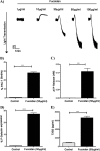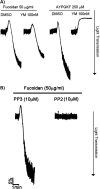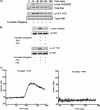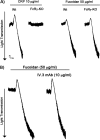Fucoidan is a novel platelet agonist for the C-type lectin-like receptor 2 (CLEC-2)
- PMID: 23341451
- PMCID: PMC3597812
- DOI: 10.1074/jbc.M112.424473
Fucoidan is a novel platelet agonist for the C-type lectin-like receptor 2 (CLEC-2)
Abstract
Fucoidan, a sulfated polysaccharide from Fucus vesiculosus, decreases bleeding time and clotting time in hemophilia, possibly through inhibition of tissue factor pathway inhibitor. However, its effect on platelets and the receptor by which fucoidan induces cellular processes has not been elucidated. In this study, we demonstrate that fucoidan induces platelet activation in a concentration-dependent manner. Fucoidan-induced platelet activation was completely abolished by the pan-Src family kinase (SFK) inhibitor, PP2, or when Syk is inhibited. PP2 abolished phosphorylations of Syk and Phospholipase C-γ2. Fucoidan-induced platelet activation had a lag phase, which is reminiscent of platelet activation by collagen and CLEC-2 receptor agonists. Platelet activation by fucoidan was only slightly inhibited in FcRγ-chain null mice, indicating that fucoidan was not acting primarily through GPVI receptor. On the other hand, fucoidan-induced platelet activation was inhibited in platelet-specific CLEC-2 knock-out murine platelets revealing CLEC-2 as a physiological target of fucoidan. Thus, our data show fucoidan as a novel CLEC-2 receptor agonist that activates platelets through a SFK-dependent signaling pathway. Furthermore, the efficacy of fucoidan in hemophilia raises the possibility that decreased bleeding times could be achieved through activation of platelets.
Figures







Similar articles
-
The novel Syk inhibitor R406 reveals mechanistic differences in the initiation of GPVI and CLEC-2 signaling in platelets.J Thromb Haemost. 2009 Jul;7(7):1192-9. doi: 10.1111/j.1538-7836.2009.03451.x. Epub 2009 Apr 24. J Thromb Haemost. 2009. PMID: 19422460
-
C-type lectin-like receptor-2 (CLEC-2) is a key regulator of kappa-carrageenan-induced tail thrombosis model in mice.Platelets. 2023 Dec;34(1):2281941. doi: 10.1080/09537104.2023.2281941. Epub 2023 Nov 27. Platelets. 2023. PMID: 38010137
-
A novel Syk-dependent mechanism of platelet activation by the C-type lectin receptor CLEC-2.Blood. 2006 Jan 15;107(2):542-9. doi: 10.1182/blood-2005-05-1994. Epub 2005 Sep 20. Blood. 2006. PMID: 16174766
-
Novel platelet activation receptor CLEC-2: from discovery to prospects.J Thromb Haemost. 2011 Jul;9 Suppl 1:44-55. doi: 10.1111/j.1538-7836.2011.04335.x. J Thromb Haemost. 2011. PMID: 21781241 Review.
-
Thrombomodulation via CLEC-2 targeting.Curr Opin Pharmacol. 2009 Apr;9(2):90-5. doi: 10.1016/j.coph.2008.11.001. Epub 2008 Dec 16. Curr Opin Pharmacol. 2009. PMID: 19091630 Review.
Cited by
-
Nanoplateletsomes restrain metastatic tumor formation through decoy and active targeting in a preclinical mouse model.Acta Pharm Sin B. 2022 Aug;12(8):3427-3447. doi: 10.1016/j.apsb.2022.01.005. Epub 2022 Jan 12. Acta Pharm Sin B. 2022. PMID: 35967283 Free PMC article.
-
PDK1 selectively phosphorylates Thr(308) on Akt and contributes to human platelet functional responses.Thromb Haemost. 2014 Mar 3;111(3):508-17. doi: 10.1160/TH13-06-0484. Epub 2013 Dec 19. Thromb Haemost. 2014. PMID: 24352480 Free PMC article.
-
Gq pathway regulates proximal C-type lectin-like receptor-2 (CLEC-2) signaling in platelets.J Biol Chem. 2017 Sep 1;292(35):14516-14531. doi: 10.1074/jbc.M117.791012. Epub 2017 Jul 13. J Biol Chem. 2017. PMID: 28705934 Free PMC article.
-
The Dectin-1 and Dectin-2 clusters: C-type lectin receptors with fundamental roles in immunity.EMBO Rep. 2024 Dec;25(12):5239-5264. doi: 10.1038/s44319-024-00296-2. Epub 2024 Oct 31. EMBO Rep. 2024. PMID: 39482490 Free PMC article. Review.
-
Synthetic glycopolymers and natural fucoidans cause human platelet aggregation via PEAR1 and GPIbα.Blood Adv. 2019 Feb 12;3(3):275-287. doi: 10.1182/bloodadvances.2018024950. Blood Adv. 2019. PMID: 30700416 Free PMC article.
References
-
- Packham M. A. (1994) Role of platelets in thrombosis and hemostasis. Can J. Physiol. Pharmacol. 72, 278–284 - PubMed
-
- Broos K., De Meyer S. F., Feys H. B., Vanhoorelbeke K., Deckmyn H. (2012) Blood platelet biochemistry. Thromb. Res. 129, 245–249 - PubMed
-
- Clemetson K. J. (2012) Platelets and primary haemostasis. Thromb. Res. 129, 220–224 - PubMed
-
- Shankar H., Garcia A., Prabhakar J., Kim S., Kunapuli S. P. (2006) P2Y12 receptor-mediated potentiation of thrombin-induced thromboxane A2 generation in platelets occurs through regulation of Erk1/2 activation. J. Thromb. Haemost. 4, 638–647 - PubMed
Publication types
MeSH terms
Substances
Grants and funding
LinkOut - more resources
Full Text Sources
Other Literature Sources
Molecular Biology Databases
Miscellaneous

